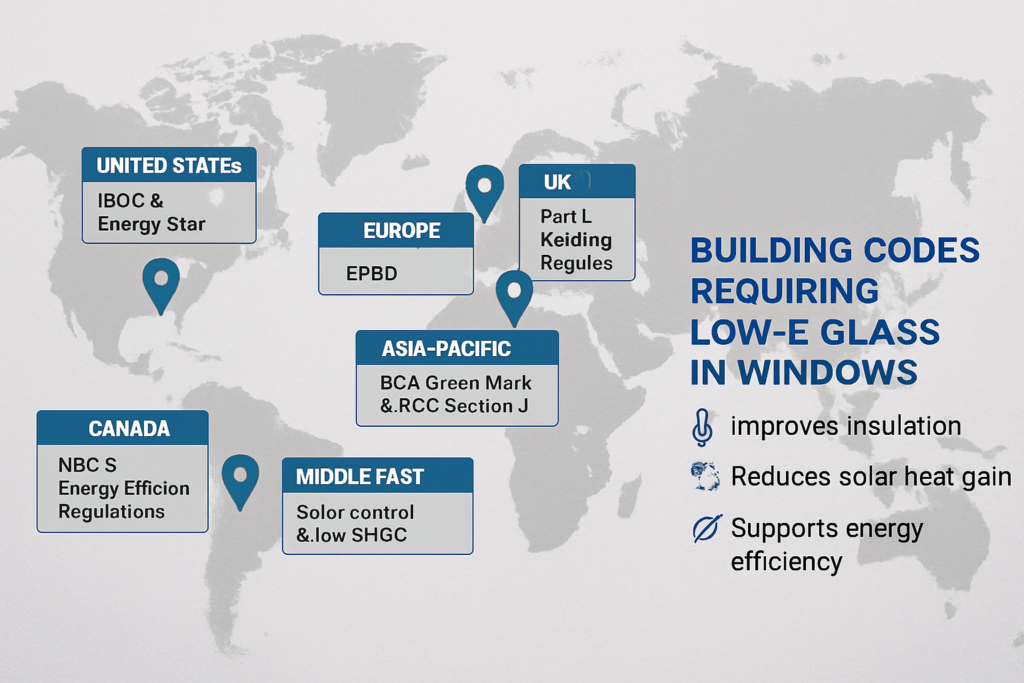As the construction industry shifts toward energy efficiency and sustainability, building codes across the world are evolving to include stricter requirements for window performance. One of the most common features now mandated in many codes is the use of glass low E.
Low-emissivity (Low-E) glass, with its thin metallic coatings that reduce infrared and ultraviolet light transmission, is no longer a premium option—it has become an essential requirement in residential, commercial, and institutional projects. In this article, we’ll explore which building codes require glass low E in windows, why these codes exist, and how Low-E glazing impacts compliance, efficiency, and design.
What Is Glass Low E?
Glass low E is glazing with an ultra-thin, transparent metallic coating that:
- Reflects infrared radiation to reduce heat transfer.
- Blocks harmful UV rays while maintaining visible light transmission.
- Improves insulation in winter and solar control in summer.
Because of these properties, Low-E glass is a major contributor to compliance with energy-efficiency building codes around the world.
Why Building Codes Require Glass Low E
Building codes are designed to reduce energy waste, lower carbon emissions, and improve occupant comfort. Windows are a major factor in a building’s thermal performance—responsible for up to 30% of energy loss.
Glass low E helps buildings meet code by:
- Reducing U-values (improving insulation).
- Lowering Solar Heat Gain Coefficients (SHGC).
- Maintaining visible light transmission for daylighting strategies.
This balance is why modern codes increasingly mandate Low-E glazing for windows, skylights, and facades.
Global Building Codes Requiring Glass Low E
1. North America
- United States (IECC & Energy Star):
The International Energy Conservation Code (IECC) requires windows to meet strict U-factor and SHGC ratings, which are almost always achievable only with Low-E glass. Energy Star window standards also mandate Low-E coatings for most climate zones. - Canada (NBC & Energy Efficiency Regulations):
The National Building Code of Canada (NBC) emphasizes energy efficiency through U-value requirements. Low-E windows are necessary to meet these performance metrics, especially in provinces with cold climates.
2. Europe
- European Union (EPBD – Energy Performance of Buildings Directive):
The EPBD requires member states to enforce energy performance standards for buildings. Low-E windows are part of achieving the thermal transmittance limits outlined in EN standards. - UK (Part L Building Regulations):
Updated Part L regulations mandate high-performance glazing with low U-values, achievable through Low-E coatings.
3. Asia-Pacific
- Australia (NCC Section J):
The National Construction Code enforces minimum insulation and glazing performance. Low-E glass is frequently required to comply with Section J for energy efficiency. - Singapore (BCA Green Mark):
Mandates energy-efficient glazing in buildings, where Low-E is the most practical solution.
4. Middle East & Beyond
Countries with hot climates, such as the UAE and Saudi Arabia, have codes requiring solar control glass with low SHGC values, where Low-E coatings are essential.
Applications in Building Projects
Residential Windows
Homeowners are required to use glass low E windows in new builds and retrofits to comply with modern energy codes.
Skylights
Overhead glazing must balance daylight with solar control. Codes now require high-performance glass, making Low-E a standard. See Why Should Glass Low E Be Chosen for Skylight Use?.
Sliding Doors
Large glass doors are another area where Low-E is preferred to meet energy targets. Learn more in When Is Glass Low E Preferred in Sliding Door Design?.
Facades and Curtain Walls
For tall commercial buildings, Low-E glazing balances daylight, insulation, and solar control, ensuring code compliance. See What Makes Glass Low E Ideal for Tall Glass Facades?.
Technical Parameters in Codes
When building codes specify glazing requirements, they focus on measurable values:
- U-Value: Measures insulation. Low-E glass is required to achieve the low U-values mandated by codes.
- SHGC: Governs how much solar heat enters. Low-E helps achieve lower SHGC targets.
- VLT (Visible Light Transmittance): Codes encourage daylighting while minimizing heat. Low-E balances these requirements.
- LSG (Light-to-Solar Gain Ratio): A critical measure for spectral selectivity.
Compliance and Construction Challenges
Ensuring compliance with glazing codes involves not just choosing the right glass but also safe and efficient installation.
- Using miter clamps helps move and install heavy Low-E windows safely.
- For oversized or multi-story facades, Transport Frame systems are often necessary for positioning large glass panels.
This ensures both compliance and long-term durability.
Environmental Benefits Aligned with Codes
Building codes don’t just focus on energy bills—they also aim to reduce environmental impact. Glass low E contributes by:
- Cutting greenhouse gas emissions.
- Supporting LEED, BREEAM, and Green Star certifications.
- Reducing reliance on artificial lighting.
For broader sustainable design insights, see Define Landscape Concepts in Modern Architecture.
Future Trends in Low-E Glass and Codes
As governments push for net-zero buildings, expect codes to become even stricter, making glass low E mandatory in almost all fenestration applications. Future innovations may include:
- Triple silver Low-E coatings for superior performance.
- Integration with smart glass technologies.
- Larger panel sizes for seamless facades without compromising code compliance.
Conclusion
Glass low E has moved from being a premium upgrade to a mandatory requirement in modern building codes worldwide. From the IECC in North America to the EPBD in Europe and NCC in Australia, Low-E coatings are critical for meeting U-value, SHGC, and daylighting requirements.
By choosing Low-E glass for windows, skylights, doors, and facades, architects and builders not only ensure code compliance but also deliver sustainable, comfortable, and future-ready spaces. Combined with safe handling using miter clamps and Transport Frame solutions, Low-E glass becomes a cornerstone of modern construction.
As the demand for greener, smarter buildings grows, glass low E will remain the standard for energy-efficient window design worldwide.

